
Regiments of the NWA
and their uniforms
Most of this information is from Aleksandr Deryabin's Белые армии северо-запада России 1918-1920 гг. (White Armies of North-Western Russia, 1918-1920).
Badges
All NW Corps were supposed to wear a large volunteer chevron in white-blue-red on the upper left arm. Unlike the VA, it was worn point up, and was often quite large. Upon the forming of the NW Army, a white cross was added inside the V.
Cockades were the former Imperial ones, orange and black ovals inside white metal. As noted below, some units added death's heads or white ribbons.
Standard Regiments
The forerunner to the NW Corps and NW Army, the "Pskov Corps" decided to stick mostly with the old Tsarist uniform. As well as the Russian national tricolour chevron, they added a white-blue-black Estonian one.
- Staff officers had gold pogoni (shoulderboards) with "Пс. К." (for Pskov Corps).
- Infantry were in rifle colours: the khaki shoulderboards were stencilled in raspberry (dark pink) with the number and letter for their regiment (so "1.Пс.", "2.O.", "3.Рж." etc). Officer braid was gold, piped raspberry.
- Artillery had "1.Пс." with added crossed guns, and officers had gold, piped raspberry.
- Engineers "1.Пс." with added crossed spade and pickaxe, and officers were silver, piped raspberry.
With the formation of the NW Corps, other than removing the Estonian markings, the system remained mostly the same. At some time the letters on the shoulderboards were dropped – with only one regiment of each number they were entirely superfluous.
It should be noted, however, that until Allied material arrived in mid-1919, that the Whites in the north-west were very poorly outfitted. Boots were rare, and clothes were often patched and torn, even for officers. Men wore whatever clothers they could find, and civilian clothes were common.
Some officers were well dressed, but often with incorrect colours from their previous units. So the picture of the NWA officer in the "White Armies" Osprey shows an infantry officer with black trousers. Photos of senior officers show quite a few wearing caps with coloured bands and piping. As Petrograd had been the base for most of the Guards units many officers these may well be Guards caps.
For Yudenich's last campaign most of the NWA were in English outfits, with Russian differences. Some units did wear French uniforms. Those wearing German uniforms are detailed below.
Due to the difficulty in recognising friend from foe, many NWA units took to wearing a white ribbon behind the cockade on their caps.
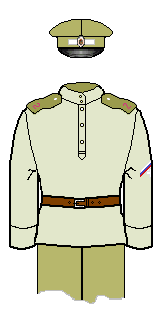 |
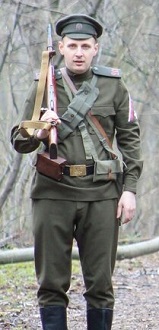 |
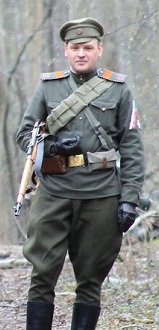 |
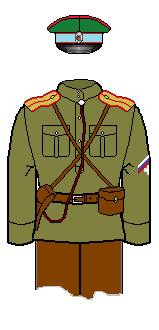 |
| Field uniform of 2nd Ostrov Regiment with ribbon behind cockade | Re-enactor private – he has opted for "2.O." rather than the plain "2" | Re-enactor NCO – still far too tidy for the actual NWA | Officer with former Guards (Semenovski) cap and civilian trousers |
Order to North-Western army No.156 on 20 July 1919: para.3.
Field uniform of 2nd Ostrov Infantry Regiment ...
Greatcoat: standard, gray cloth, single-breasted, buttons to middle, raspberry edging on collar, on cuff sleeves, on sides and on strap. Tabs of black cloth with raspberry edging and buttons.
Blouse*: khaki with "fall collar" and pockets on breasts, raspberry edging on upper collar edge, collar, cuffs and pockets flaps.
Trousers**: Wide, khaki with raspberry piping.
Service cap: khaki, raspberry piping.
Pogoni: Raspberry with white edging and cipher "2".For officers - gold with raspberry middle and white edging.
* Officers are permitted to wear a service jacket with edging on upper collar edge, on cuffs and pockets flaps.
** Cavalry may have navy or blue green
It is extremely doubtful many of the Ostrov men wore the fully piped uniform, given that most were in English outfits by that point.
Bulak-Balakhovich Detachment
The history of this unit can be found here.
The unit's colour was yellow, even before they joined the Whites, to the extent that they were nick-named the "yellow parrots". Bulak-Balakhovich styled himself, and it seems his units, very much in Cossack style, presumably to play up their partisan origins.
The 1st Divizion had yellow shoulderboards with dark blue edging, while the 2nd had raspberry (as rifles) with yellow edging. Trousers were dark grey-blue with yellow stripe. The kubanka had a yellow top, and some of the men added a large skull-and-crossbones as badge on the front, in honour of the Punin partisan unit that Balakhovich had served with in WWI (but these hats may have been his personal squadron only). The field cap oddly did not seem to have a yellow band, but was plain khaki.The 2nd Divizion was largely formed from deserters, from both Whites and Reds. It was quite poorly dressed, and it seems unlikely that many of the rankers wore the full coloured shoulder-boards.
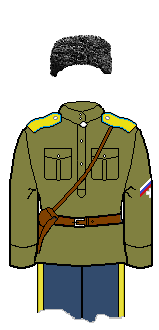 |
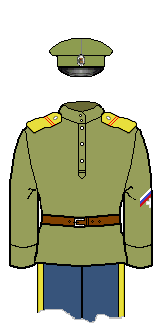 |
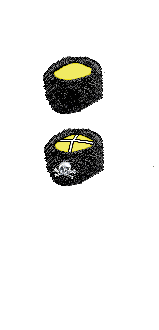 |
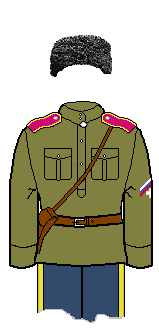 |
| Officer in 1st Division | NCO in 1st Division | Kubanka – normal practice was only officers had a cross | Officer in 2nd Division |

Bulak-Balakhovich in Pskov in 1919. While grainy, we can see that most men are wearing caps, and there is a squadron swallow tailed standard, presumably in yellow and blue, perhaps with a "B" in it. He is a wearing a Cossack bashlyk rather than greatcoat.
Lieven Division
Prince Lieven formed a unit of ethnic Russians in Latvia to fight the Bolsheviks. They fought beside the Freikorps in early 1919 to push out the Bolsheviks, but refused to take part in the campaign which led to the Battle of Cesis, as that was not against Bolsheviks.
The unit grew quite large. By June 1919, it had 3,500 bayonets and sabres, including three infantry regiments; a rifle divizion, a 3 gun battery, a four howitzer battery, two armoured vehicles, three planes and part of a railway battalion.
They were then called in mid-1919 by the North-Western Army to aid in the attacks towards Petrograd. Unlike Bermondt-Avalov and Virgolich, Lieven was primarily motivated by the anti-Bolshevik struggle, and his men were shipped to Estonia. By this stage he had been wounded and was unable to continue to command in person, but the unit kept his name.
Having been fitted out initially by the German Freikorps, his men arrived entirely dressed in German uniforms, albeit with Russian insignia. They were unusual in the NW Corps of the time for being well dressed and equipped. They were also one of the better units of the NWA, having fewer impressed ex-Reds.
The other ranks wore basically standard German WWI uniforms, with shoulderboards with the Cyrillic "Л" for Lieven, with a crown. The coloured side was light blue, piped white. Officers had gold braid.
The ranks seem to have all worn helmets, some with the Imperial double headed eagle on them. The officers wore either German uniforms, or Russian if available. Later on the units moved to English uniforms as their old ones wore out.
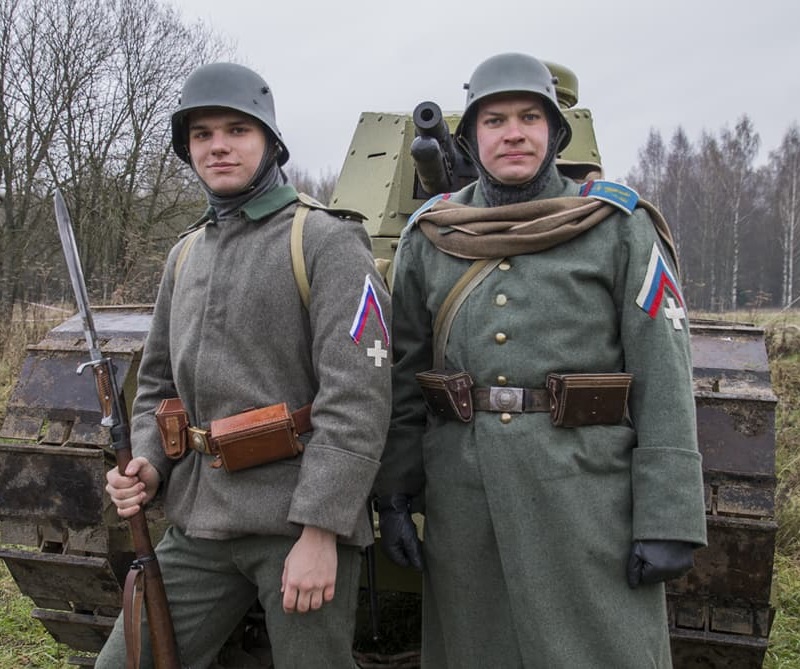
Re-enactors of the Lieven Division
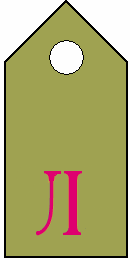 |
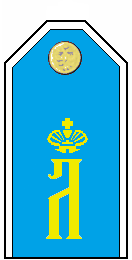 |
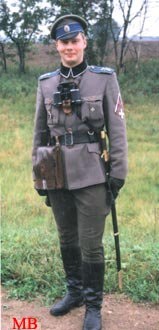 |
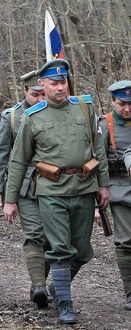 |
| Khaki shoulderboard, with the 1914 standard stencil "L" |
Coloured Shoulderboard, with the older fashioned "L" and crown | Re-enactor officer, in German uniform | Re-enactors, with company standard on rifle bayonet |
It seems odd that the regiments did not have numbers as well as the L on their shoulderboards, because they did on their standards (they were officially the 17th Libava, 18th Riga, 19th Poltava, but I think they continued to regard themselves as 1st, 2nd and 3rd Lieven).
There is some disagreement about the flags. Deryabin has black letters in a white cross on a tricolour:
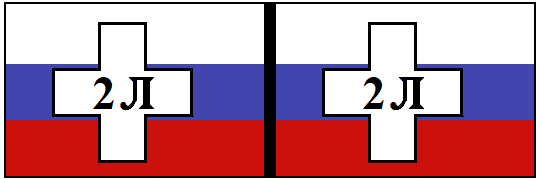
The Posev Photoalbum shows similar, but the cross edged in gold and the front having a crowned "L" instead.
However, russianestonia.eu has the following picture, with an old-fashioned Cyrillic L with crown on the front in gold, and the number 3 on the back, also in gold.

Period photos can be found here: Estonian Russia
Baltic Regiment
Formed from ethnic Germans of Estonian origin, it started as a battalion, before becoming a regiment in May 1919, with an infantry battalion, cavalry squadron, battery and some other units. Although formally Estonian, it spent most of 1919 fighting alongside the NWA, at its own request.
Most of the uniform was German, including helmets, although mixed with Russian and Allied pieces as well. Its chevron was white over black over a white cross. It had Russian style shoulder-straps in black piped white, with a white "B" and rank markings in silver for officers. While stylistically Russian in uniform, it had German ranks (as that was the language of the men).
Its standard was, I believe, a black German cross on white.
Russian Estonia has some information about them.
